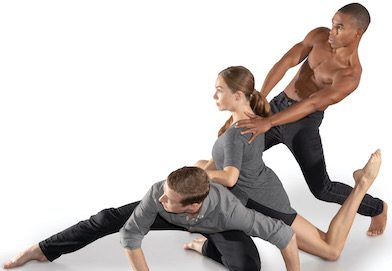ST. LOUIS — The show must go on, as they say. Though this mantra has been questioned throughout the past year, as a raging pandemic, political upheaval, social unrest and economic despair have put arts organizations’ very survival to the test. The Big Muddy Dance Company opted to press ahead, making the most of a bad situation by pivoting to virtual classes and online social events, almost immediately. By November, they’d figured out an effective way to present dance on film, recreating their popular story ballet, Lemp Legends, for the screen.
With last weekend’s mixed-rep, Big Muddy adds streamed concerts to its arsenal of digital possibilities. Pre-recorded at the Grandel Theatre, the package of four world premieres, collectively titled Collide, was on view whenever we wanted from Jan. 22-24.
It was in that “anything goes” spirit that Big Muddy’s leadership introduced the performance. Seated in the Grandel’s orangey chairs—a few seats apart for social distancing—executive director Erin Prange and artistic director Brian Enos invited viewers to stay in their pajamas, grab a bowl of popcorn, sit back and relax… while simultaneously teasing the possibility of a few live productions this spring. With hope, more than confidence, that this may be the case, dance audiences are still largely relegated to their screens, for now—particularly those of us from wintry locales.
For that reason, I wouldn’t say Collide completely scratched my dance itch; in hindsight, I rather like the pomp of a live performance with its lobby mingling and uncomfortable shoes, the scramble to find parking and the peculiar smell of a fog machine in use. There’s none of that here. Following Enos’ advice I settled in on my couch, in sweatpants on Sunday afternoon to take in Collide.
The quartet of works, however, reassured me of Big Muddy’s strength, resilience, adaptability and versatility. Mixed-rep concerts, varied by design, give dance companies a lot of elbow room to try on a multitude of styles in the same evening. In just over an hour, Big Muddy offered a peek into their three-pronged, something-for-everyone approach to programming: classic contemporary dance, period narratives and avant-garde experimentation.
The first and last pieces on the bill—Jenny Battenberg’s The Upheaval for the Big Muddy trainees and Enos’ #crowdsource choreo developed from social media suggestions—sit comfortably in what one might call a “pretty contemporary dance” vibe, with graceful, liquid-like bodies peppering the stage with occasional punctuations through the hands and feet, occasional partnering and, in the case of #crowdsource choreo, a hint of absurdity with a calypso track opening and closing the dance.
Between these bookends are two others: There’s Dallas-based choreographer Joshua Peugh’s premiere, My Dear Watson, a Victorian-styled septet that sketches a vague mystery, presumably one involving Sherlock Holmes and his trusty sidekick. Set to a playlist by the Molotow Brass Orkestar—a Swiss brass-plus-percussion ensemble whose sound uniquely blends polka, klezmer, ska and Truba—the piece deepens Big Muddy’s foray into period dramedies (see also: Lemp Legends and A Christmas Carol), complete with full skirts and bustles for the women and waistcoats for the men. Add to that a hint of Mystery Science Theater, with half the cast beginning in the first row of the Grandel, cast in silhouette before bounding to the stage to join the others.
On the surface, Prince Lyons’ Black Birch could not be more different than My Dear Watson, though one could argue there’s a through-line in the way silliness and seriousness shake hands in both pieces. Unrecognizable, the dancers wear skimpy underthings covered over by hosiery and satin, purple opera gloves. The hose veil even their heads and masked faces like a translucent burglar hood, further obscuring their very humanness as the group undulates on all fours, as if in some primordial state.
Every joint of the body articulates individually. Indeed, each rib and vertebra appears to operate on its own. The music, too, functions independent of any attachment to the choreography until the very end, when the group snaps into tempo with an electronica track by composer Jasmine Infiniti. On the way there, it’s the in-betweens of Black Birch that are the most interesting. There’s a lined-up gesture series in silence, in which all seven dancers (Seven, apparently was the magic number, presumably dictated by health recommendations) cycle through an additive phrase of surprised Marilyn Monroe-esque poses. Best of all is a duet of two men, hands shod with stilettos, sauntering a diagonal pass like slithering centaurs, stopping every so often to bend their bodies backward, folding nearly in half.
—
Header photo by Gerry Love, courtesy Big Muddy Dance Company
